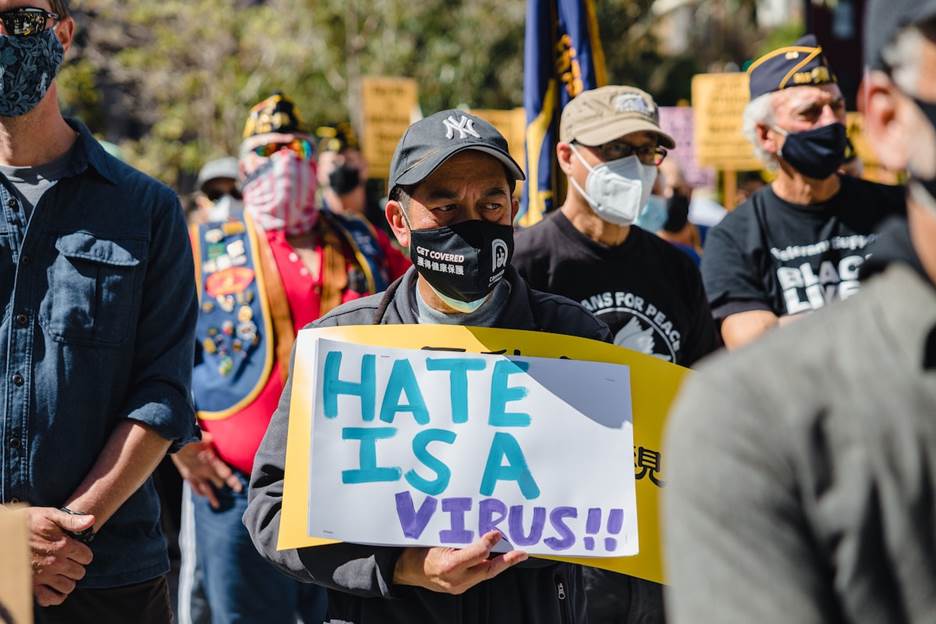
The ACT Against Hate Alliance brought together some heavy hitters from law enforcement to discuss strategies for combatting the recent rise in hate crimes
No Tolerance for Intolerance: Law Enforcement Vets Strategies to Combat Hate Crimes
By Mark Hedin
As the United States experiences an escalating wave of hate crimes, particularly victimizing Asian Americans, ACT Against Hate Alliance brought together some heavy hitters from law enforcement to discuss strategies for combatting this alarming trend.
“The core mission of the ACT Against Hate Alliance is to identify the root causes behind hate crimes, and propose solutions to stop them,” co-host Bob Huff, former California state senate minority leader, said in introducing the Feb. 8 panel, the sixth in a monthly series the organization is hosting while also opening chapters on campuses throughout the state.
“We’re all stakeholders,” said Domingo Herraiz, of the International Association of Chiefs of Police. “When an incident or hate crime occurs, it truly rocks the community and the credibility of government and policing agencies. The sense of safety for all in the community is badly damaged.
“If the investigation falls apart, if there’s no prosecution, no charges, we have long-term, long-lasting effects and devastation to the community.
“We need to speak up, because we are the majority, and we cannot tolerate this. We weren’t raised this way. Very, very few people were.”
Inflammatory political, online rhetoric
Jim McDonnell , whose decades in law enforcement included stints as Long Beach police chief after almost 30 years with LAPD, and as LA County sheriff from 2014-18, overseeing 18,000 employees and a $3.3 billion budget, attributed some of the near-doubling of hate crime reports in the past decade to inflammatory leaders and unchecked social media that “encourages people who can hide in the dark” to anonymously spew hate encouraging and rewarding like-minded others for “something very hurtful to our community.”
“That lack of accountability, I think, separates where we are today from where we were 20 years ago, as it relates to hate crimes in particular, but other crimes and aberrant behavior as well,” he said.
He cited improvements in data collection thanks to a new “NIBR” (National Incident Based Reporting) system that will improve coordination between various law enforcement agencies and jurisdictions. Besides leading to a more complete picture of what is widely believed to be an underreported crime phenomenon, he said, NIBR is expected to make it easier to identify trends and capture specifics about individual crimes.
“We have a relatively small number of people in our society who would engage in this type of behavior,” he said. “So, it’s important that those in law enforcement be aware of who those individuals are, what groups they’re affiliated with, and how they operate.”
“We dedicate a ton of resources to hate crimes,” said FBI Special Agent Brian Gilhooly , who oversees criminal investigations across seven southern California counties, dealing with gangs, narcotics, violent crime, hate crime, public corruption, crimes against children and fraud.
“It’s not only an attack on a victim. It has a huge impact on the entire community, which is why it’s a priority for the FBI.”
Reporting hate crimes
“It’ll take a team to really make an impact on this threat,” the former Navy SEAL officer in the Middle East and Pacific regions said, “and here in Los Angeles, we are one of the only field offices that has an entire squad dedicated to investigating hate crimes.”
There “is a button for tips and leads” on the FBI website , Gilhooly said. “We can use that information to better prepare our law enforcement or intelligence analysts, our victim specialists or our language specialists to address these important issues.”
“Most people set the bar relatively high for reaching out to law enforcement,” Gilhooly added, “thinking that they might need to actually have some physical violence.” But, to enable better understanding of community dynamics and to target investigations on the worst offenders, he said, “Harassment and other forms should also be reported to law enforcement.”
And perhaps “not commonly known,” he said, are other resources available, primarily to victims, that include community outreach specialists “who speak all manners of foreign languages.
For cultural understanding, he said, “being able to communicate in someone’s first language makes it a little bit easier to talk about some difficult problems.”
More accountability for perpetrators of hate crimes
Walt Allen, Covina mayor pro-tem and a 46-year law enforcement veteran, who helps oversee police training for police recruits throughout southern California, also described a need to do more to hold people accountable for their actions, something he felt has diminished in recent years.
“If people are not held accountable, you’re going to have continuous behavior. We need to set an example for those people who do wrong and hold them to the letter of the law.”
He described a new emphasis in police training on investigating hate crimes and dealing empathetically with its victims, and said he has high hopes for the recently enacted CARE act, state Senate Bill 1338 , that begins to address the needs of people diagnosed as severely mentally ill.
“Severe mental health issues are a driving force behind violent crime in California,” he stated.
“If you tolerate it, you encourage it,” said Denton Carlson, police chief in the northern California city of San Ramon, whose department was able to rapidly respond to and defuse some incidents over the holidays late last year.
“If you don’t take actions to stop it, it’s just going to keep occurring and flourish.”
“You often hear people say that ‘hey, somebody should do something about that,” Herraiz said. “Well, we’re all somebody who can step up and play a role in our own way in affecting what happens in the future.” – Ethnic Media Services

